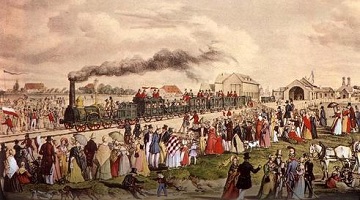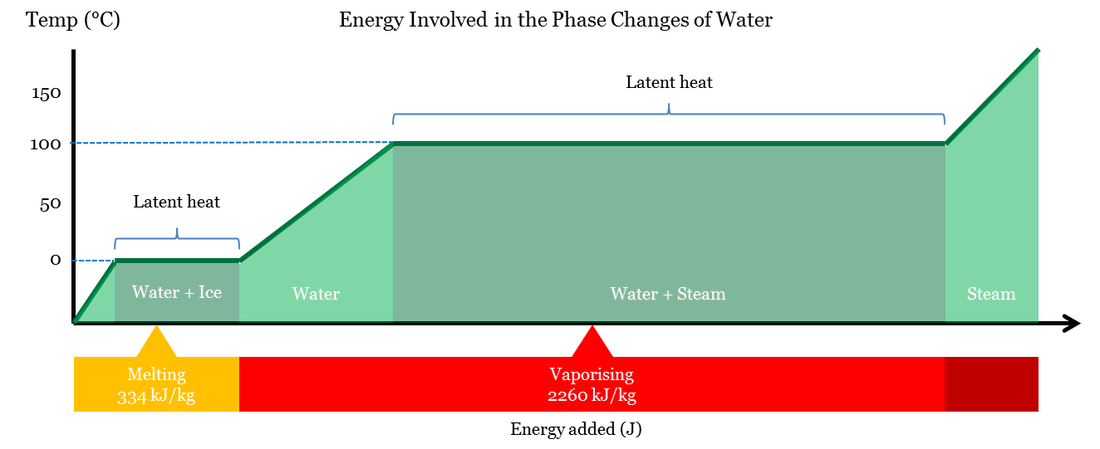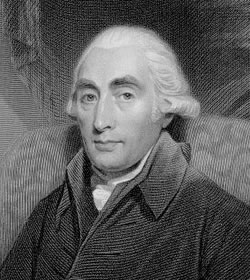|
With Part 1 we covered the origins of physics, the questions that gave birth to it as well as the though process of early physicists. With Part 2, physics came of age with the application of the scientific method and mathematics.
In this third part of the series, we discuss how physics itself is applied to the real world and its problems. |
"The Industrial Revolution was a watershed in the history of mankind. Three forces – technology, economic organization, and science, in this sequence – each from separate and undistinguished parentage, linked up, inconspicuously at first, to form, hardly a hundred years ago, into a social maelstrom that is still engulfing new and new millions of people, in an irresistible rush." - Karl Polanyi, "For a New West" (1958)
The last time we discussed the Story of Physics, we left Newton basking in the glory of his theory of gravitation. We can safely assume that left the world being proud of his discoveries, all neatly tied up with empirical evidences provided by Brahe and Keppler, as well as his calculus which correctly predicts the motions of everything from cannonballs to planets and moons.
The Newtonian theory, now known as classical mechanics, held up perfectly well for more than 300 years. But again, as we say in IFSA: science marches on! With the coming industrial age in the 18th and 19th centuries, physics play a greater role in daily life; that is, applied physics. As scientists and engineers try to solve real-world problems, physics advanced with them.
The first of these advances is prompted by none other than the steam engine. Since the early 18th century, the steam engine have been used to pump water out of the coal mines of Northern England. Unfortunately, and ironically, these early engines consumer more coal than they’re worth, making the whole notion of increasing the productivity of a coalmine, moot. The problem is heat wastage, operators have no idea how much coal to feed the infernal machine to produce how much steam at how high a temperature to produce how much pressure.
The Newtonian theory, now known as classical mechanics, held up perfectly well for more than 300 years. But again, as we say in IFSA: science marches on! With the coming industrial age in the 18th and 19th centuries, physics play a greater role in daily life; that is, applied physics. As scientists and engineers try to solve real-world problems, physics advanced with them.
The first of these advances is prompted by none other than the steam engine. Since the early 18th century, the steam engine have been used to pump water out of the coal mines of Northern England. Unfortunately, and ironically, these early engines consumer more coal than they’re worth, making the whole notion of increasing the productivity of a coalmine, moot. The problem is heat wastage, operators have no idea how much coal to feed the infernal machine to produce how much steam at how high a temperature to produce how much pressure.
Turning up the Heat
Enter Joseph Black, a Scottish professor of chemistry at the University of Glasgow, and later Edinburgh. In 1761, he discovered that the application of heat does not necessarily increase the temperature of the substance. An experiment was devised to prove this theory of ‘latent’ heat by measuring the temperature of a block of ice as it melts into liquid water, and later, that of boiling water and the steam it produces. This discovery, heralding the arrival of a new branch of physics, provides a guide on heat expenditure and conservation, which then resulted the development of more energy efficient and powerful steam engines – just in time to power the Industrial Revolution.
Thermodynamics, as it is now known, isn’t the only hot, new physics of the age. Application can come after much fruitless tinkering by the theorists and experimentalist, as the first and foremost nature of science is to discover, anything else is derivative. Similarly was the case with electricity; for centuries, the existence and effects of electricity have been known, though not fully understood. Chemical reactions can be measured, swinging pendulums can be timed – but what about electricity?
Enter Joseph Black, a Scottish professor of chemistry at the University of Glasgow, and later Edinburgh. In 1761, he discovered that the application of heat does not necessarily increase the temperature of the substance. An experiment was devised to prove this theory of ‘latent’ heat by measuring the temperature of a block of ice as it melts into liquid water, and later, that of boiling water and the steam it produces. This discovery, heralding the arrival of a new branch of physics, provides a guide on heat expenditure and conservation, which then resulted the development of more energy efficient and powerful steam engines – just in time to power the Industrial Revolution.
Thermodynamics, as it is now known, isn’t the only hot, new physics of the age. Application can come after much fruitless tinkering by the theorists and experimentalist, as the first and foremost nature of science is to discover, anything else is derivative. Similarly was the case with electricity; for centuries, the existence and effects of electricity have been known, though not fully understood. Chemical reactions can be measured, swinging pendulums can be timed – but what about electricity?
A Spark of Genius
For most of the 18th century, electricity was simply a novel curiosity. The first form discovered, static electricity, became quite a sensation whereby people (purposely) shock themselves, either for entertainment or therapeutic use. After much experimentation by figures such as Stephen Gray (discovered the principles of conductivity), Charles Francois du Fay (electrical charges), Pieter van Musschenbroek (capacitance), and the illustrious Benjamin Franklin (electrical potentials), the theory of electrodynamics began to form sufficiently enough for applications in the 19th century.
For most of the 18th century, electricity was simply a novel curiosity. The first form discovered, static electricity, became quite a sensation whereby people (purposely) shock themselves, either for entertainment or therapeutic use. After much experimentation by figures such as Stephen Gray (discovered the principles of conductivity), Charles Francois du Fay (electrical charges), Pieter van Musschenbroek (capacitance), and the illustrious Benjamin Franklin (electrical potentials), the theory of electrodynamics began to form sufficiently enough for applications in the 19th century.
At the dawn of the 19th century, Alessandro Volta provided the means to enable the actual use of a continuous electrical current. His ‘voltaic pile’, now known as the battery, was first employed in chemistry by Sir Humphry Davy who decomposed compounds into their basic elements, giving birth to electrochemistry. But things didn’t really take off until the relationship between electricity and magnetism was accidentally establish by Danish physicist Hans Christian Ørsted when he noticed that the needle of a misplaced compass twitches during his experiments using the voltaic pile.
A flurry of applicable principles poured out as a result of the discovery of electromagnetism. Michael Faraday’s law of induction produced the electric motor and generator, Andre-Marie Ampere’s circuital law rationalizes the flow of currents and therefore heralded the transmission of electrical power, and Georg Ohm tempers it with an understanding of resistance. And though it came late in the industrial revolution, the electrification of modern society extended it to create humanity’s first era of globalization. Telegraph lines extend throughout empires and across oceans, an investor in London may get price updates on the Paris stock market in a matter of hours, radio allows instant transmission of information, and not to mention the telephone and street lighting.
A flurry of applicable principles poured out as a result of the discovery of electromagnetism. Michael Faraday’s law of induction produced the electric motor and generator, Andre-Marie Ampere’s circuital law rationalizes the flow of currents and therefore heralded the transmission of electrical power, and Georg Ohm tempers it with an understanding of resistance. And though it came late in the industrial revolution, the electrification of modern society extended it to create humanity’s first era of globalization. Telegraph lines extend throughout empires and across oceans, an investor in London may get price updates on the Paris stock market in a matter of hours, radio allows instant transmission of information, and not to mention the telephone and street lighting.
The Missing Link
All these developments in thermodynamics and electromagnetism had therefore rounded out the achievements of classical physics. The cycle seems to be complete: the hypotheses of the ancients, the experiments of the Renaissance, the theorems of the Age of Enlightenment, and the applications during the Industrial Revolution.
But something was amiss. A lingering notion of how detached these branches (classical mechanics, thermodynamics, and electromagnetism) are.
If we were to adopt the views of the Enlightenment, that the universe is akin to some super-complicated mechanical clockwork governed by mathematics, then there must be a single, unified way to rationalize it all. Just as much we can trace the source of the movements of all three hands of a clock down to its regulating pendulum.
The quest for the unification of every principle in physics is now at hand. Of which we will continue in the next part of this series.
All these developments in thermodynamics and electromagnetism had therefore rounded out the achievements of classical physics. The cycle seems to be complete: the hypotheses of the ancients, the experiments of the Renaissance, the theorems of the Age of Enlightenment, and the applications during the Industrial Revolution.
But something was amiss. A lingering notion of how detached these branches (classical mechanics, thermodynamics, and electromagnetism) are.
If we were to adopt the views of the Enlightenment, that the universe is akin to some super-complicated mechanical clockwork governed by mathematics, then there must be a single, unified way to rationalize it all. Just as much we can trace the source of the movements of all three hands of a clock down to its regulating pendulum.
The quest for the unification of every principle in physics is now at hand. Of which we will continue in the next part of this series.
Ponder this
Contrary to popular belief, the steam engine was actually invented in the late 17th century by a Frenchman, Denis Papin. However, why did it took so long to be adopted widely?
Why wasn't mathematics applied to the research of electricity much earlier? What seems to be the missing link?
Discuss
The scientific method's long journey from positing hypotheses, experimental validation, and formulating theorems, before considering applications seems directionless. In the meanwhile, science fiction have shown to inspire research in the basic sciences. The Star Trek series for example had been crucial to the modern development in communications, health, transport and defense.
Should we reverse this paradigm of 'build what we can imagine' to something more akin to 'imagine what we can build'? Why and why not?
Further readings
Joseph Black, if James Watt is the father of the steam engine, Joseph Black is its incessant, pestering school teacher for its efficient use.
The role of steam power in the Industrial Revolution, one of the first modern examples of the applied sciences.
Electrification, proof that frivolous research may yield massive unintended benefits.
Classical physics, what we have been covering from Part 1 to Part 3. Part 4 will cover things beyond this....weird things...

















